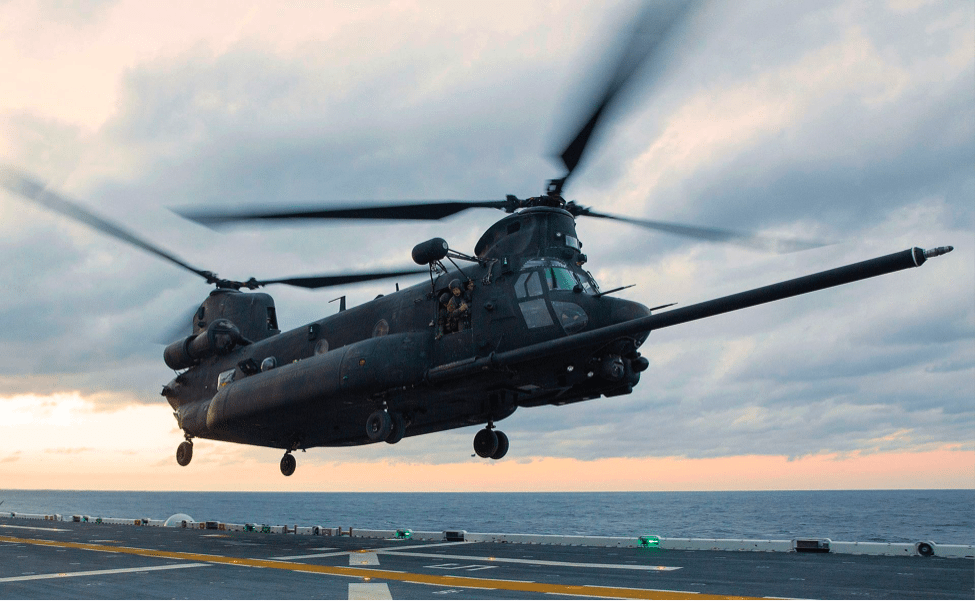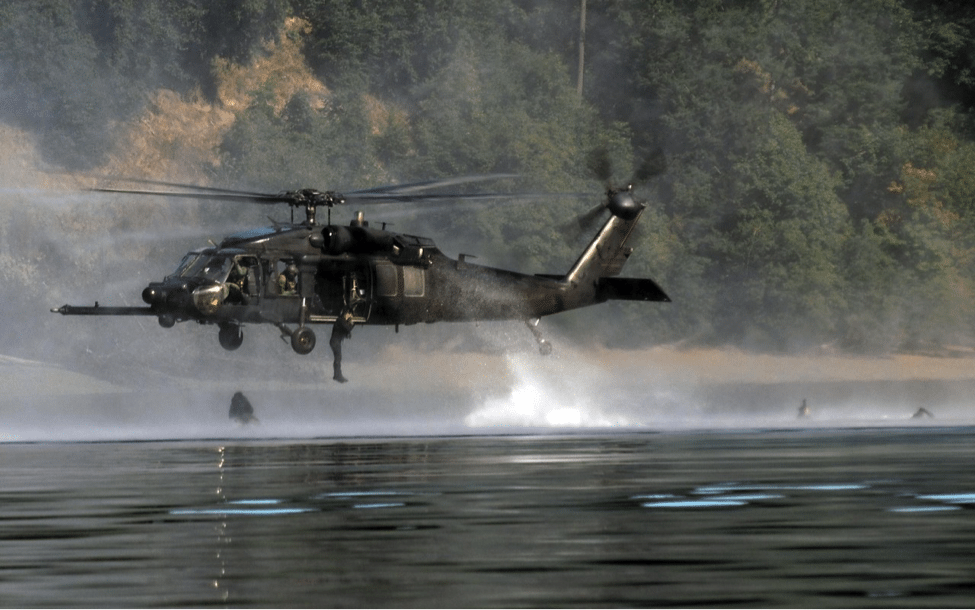Operation Eagle Claw: The Rescue Mission That Died in the Desert
Still Do-Able But Marginal
Now running behind schedule, the six Bluebeards made their way to Desert One and landed by 0130 local time in what the haboob left behind- ankle-deep fine dust that rotors stirred up and turbine engine intakes ingested. When Bluebeard 2 landed it was determined that its secondary hydraulic system had gone down, leaving the force with only five flyable RH-53Ds to carry on with the mission. There was heated discussion about the status of Bluebeard 2 but the Navy understandably refused to fly it on the mission.

Command Decision
The on-scene commander, legendary Delta commander Charlie Beckwith, did not want to reduce the size of the rescue team to fit on only five helicopters. Available intelligence about the location of the hostages within the Embassy indicated potential alternate plans might have been successful, but this information was discounted. Fearing potential problems with getting the cranky helos back into the air after they spent many hours shut down at Desert 2, the decision was reached to abort. The decision was run up the chain of command all the way to President Jimmy Carter, who concurred. Having spent two and a half hours at Desert One, the only thing left to do was get everyone out of the Iranian desert and back to Masirah.
Collision and Tragedy
Because the EC-130Es had been idling on the ground for so long Republic 4 was short of fuel. Bluebeard 4 was also short of fuel. In order to satisfy the fuel needs of these two aircraft some shuffling had to be done. Bluebird 3 was located behind Republic 4. In order to refuel Bluebeard 4 the two helos needed to switch positions. When Bluebeard 3 transitioned to hover taxi a tremendous dust and cloud was created. An Air Force controller was staggered backward by the dust and sand blasted into the air by Bluebeard 3. The pilot of Bluebeard 3 interpreted the controller’s movements as directions and he began forward movement. Spotted close to Republic 4 to begin with, it didn’t take long for Bluebeard 3 to clip the vertical stabilizer of the EC-130E and then crash into the cockpit area of Republic 4.

Bugging Out For Good
Eight servicemen died in the explosion and fire that followed. Five of the 14 aircrew on the EC-130E Republic 4 (Major Richard L. Bakke, Major Harold L. Lewis, Major Lyn D. McIntosh, Captain Charles T. McMillan, and Technical Sergeant Joel C. Mayo), and three of the five aircrew aboard the RH-53D Bluebeard 3 (Staff Sergeant Dewey L. Johnson, Sergeant John D. Harvey, and Corporal George N. Holmes). Several troops already loaded inside Republic 4 were able to abandon the aircraft. Miraculously there were no other deaths and few injuries among the scores of other personnel then on the ground at Desert One. The remaining RH-53Ds were abandoned in place, their crews piling aboard the remaining two EC-130Es. In their haste to depart the scene, which was drawing more and more interest by the minute, the Bluebeard crews failed to destroy all of the RH-53Ds themselves or weapons and highly classified mission documentation inside them.
Recovery and Scatter Plan
Republic 5 and Republic 6 brought the remaining personnel back to Masirah. There two of the C-141s that would have carried the hostages out of Iran instead flew the badly burned pilot and copilot of Bluebeard 3 and the other wounded personnel, as well as the remainder of the Delta troops, Rangers, and other personnel out of the area to an abandoned Russian airfield in Egypt at Wadi Kena. The wounded were then flown to Ramstein Air Force Base (AFB) in Germany for treatment.

Out of the Bad Came Some Good
The debacle at Desert One has had several lasting and profound effects on the way American armed forces, and especially special operations personnel, conduct their serious business. The United States Special Operations Command (USSOCOM) became operational on April 16th 1987. USSOCOM oversees and assigns special operations forces from each of the services, improving training and coordination of these highly specialized operators.

Building a Better SOAR
The majority of the nation’s special operations-capable aircraft are now equipped with systems that would likely have helped the operators in the desert that night at Desert One. The Army’s 160th Special Operations Aviation Regiment (SOAR), the Night Stalkers, is equipped with Boeing Vertol MH-47G Chinook and Sikorsky MH-60M Black Hawk helicopters that are capable of in-flight refueling and are equipped with terrain and weather avoidance systems, and lighting systems that are compatible with night vision goggles. The USAF also flies similarly equipped special operations aircraft.
Five things you might not know about Operation Eagle Claw:
- Project Honey Badger was to be the second rescue attempt. Personnel and aircraft requirements began in manageable scale but numbers quickly mushroomed to the point where it would take a more than fifty aircraft and a battalion (read hundreds) of troops. Because the RH-53Ds failed the first time around, it was determined that a special short takeoff and landing (STOL) aircraft would be needed…
- That aircraft, the YMC-130H, was at heart a Lockheed Hercules four-engine airlifter heavily modified to allow it to land and takeoff inside a stadium in Tehran and then recover aboard an aircraft carrier to offload wounded. Operation Credible Sport took an MC-130H Combat Talon assault airlifter and added rocket thrusters to slow the aircraft on landing and get it off the ground quickly on takeoff. Credible Sport would create the world’s largest and heaviest STOL transport. If it worked. Which it did not, failing spectacularly when the rockets used to slow the aircraft were fired while still airborne during a full-up systems test at Eglin Air Force Base (AFB) on October 29th
- Project Honey Badger exercises continued through the remainder of President Jimmy Carter’s term and through the 1980 Presidential election. When Ronald Reagan became the President the exercises were halted as unnecessary. Some of the tactics created for Project Honey Badger are still used by special operators today.
- Two of the Navy RH-53D Sea Stallion helos abandoned in the desert, Bluebeard 2 and Bluebird 8, fly today with the Islamic Republic of Iran Navy.
- The Lockheed EC-130E Republic 5 continued to serve with the USAF and was finally retired in June of 2013. The aircraft is now on display at the Carolinas Aviation Museum.




At the time of Operation Eagle Claw, the Psyops EC-130E name was not Commando Solo, instead it was Coronet Solo, because Air Force Special Operations were a part of TAC, the name of Commando Solo came about once Air Force Special Operations Command was activated, TEN YEARS after Eagle Claw. The second attempt was codenamed Operation Honey Badger, not “Project Honey Badger”. The YMC-130H was not a modified MC-130 Combat Talon-II aircraft; the MC-130H entered service years after Eagle Claw, also Ramstein is not an Air Force Base, because, USAF installations on foreign soil are designated as Air Bases, the Air Force Base designation is only used for USAF installations on US soil. Now, the Special Ops choppers flown by the Army are assigned to the 160th SOAR (Airborne), but, the air force no longer has Special Operations helicopters, instead, AFSOC flies the CV-22B Osprey for missions that the MH-60G Pave Hawk, and MH-53M Pave Low-IV used to fly.